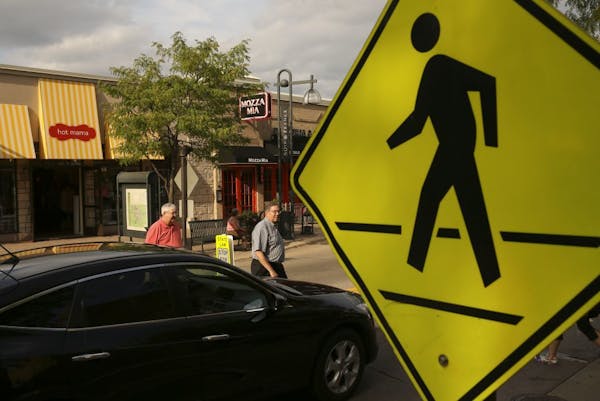The woman in a silver sedan rolled through a Rice Street crosswalk in St. Paul during the lunch hour Tuesday and didn't see the pedestrian attempting to cross the road. But a police officer in an unmarked squad car did, slapping her with a $186 ticket.
Over the course of 90 minutes, four officers camped out in the Sears parking lot watched as volunteers from the Minnesota Department of Transportation walked back and forth in a crosswalk, then tagged motorists who failed to yield the right of way, one of the leading causes of vehicle-pedestrian deaths and injuries.
It was all part of a campaign to educate drivers about the state's crosswalk rules and remind drivers to be watchful for those crossing the road on foot. Police spotted so many violators they could not catch them all.
The number of pedestrians killed on state roads this year is already at 37 — up from 23 at this time last year. Plus, October, the most dangerous month for pedestrians, is just getting started. "With more hours of darkness in the fall, pedestrians are more difficult to see," said Jay Hietpas, MnDOT state traffic engineer.
Last year there were 41 pedestrian deaths for the entire year and 904 injuries.
"You have to be careful and prudent because cars are not watching for pedestrians," said Ruth Simpson, a lobbyist from St. Michael, who crossed Rice Street on her way to a state office building.
This year in St. Paul alone, there have been 117 crashes involving vehicles and pedestrians through Sept. 23, resulting in 91 injuries and three deaths. Those numbers are why St. Paul police and neighborhood groups and organizations such as MnDOT have teamed up to hold 53 crosswalk campaigns throughout the city over the past year with the goal of changing driver behavior.
In the past 12 months, police have handed out 481 citations and 36 warnings during 53 pedestrian safety events. In more than half of cases that officers issued citations to drivers who did not stop, most drivers said they didn't see the pedestrian, said Sgt. Jeremy Ellison of St. Paul police.
"That tells us that they were not paying attention" Ellison said, while radioing to officers to stop a red Monte Carlo that drove through a crosswalk as pedestrians were stepping into the street. "Drivers need to look at their whole field of view and be actively looking for them."
Driver distraction, inattention and failure to yield the right of way are the three leading causes of vehicle-pedestrian crashes, according to the Minnesota Department of Transportation.
In some cases, however, drivers simply don't understand the crosswalk law, said officer Josh Moore who cited a driver for that reason Tuesday. A motorist heading south on Rice Street found out the hard way. Moore said she told him that she didn't know she had to stop for pedestrians who were in the northbound lanes of the divided street and had not reached the median or her lane.
For the record, state law requires that drivers stop for pedestrians at marked crosswalks and at all intersections without crosswalks or stop lights. Drivers must remain stopped when a pedestrian is coming toward them, even if they are on the opposite side of the street. It is OK to proceed once a pedestrian is behind them and cleared the driver's lane.
Pedestrian safety has become a big problem here and nationwide, with an average of one death every 2 hours and one injury every 7 minutes, according to the Center for Disease Control and Prevention.
Besides enforcement and education campaigns, some cities are looking at engineering changes to catch motorists' attention. In St. Paul, the city is looking at placing pavement markings further back from crosswalks to give drivers on roads with two lanes heading in the same direction better sightlines to see around a vehicle that may have stopped for a pedestrian.
In March, Shelby M. Kokesch, 24, of Crystal, was killed after she and her 64-year-old mother were hit by a sport-utility vehicle while crossing Kellogg Boulevard in downtown St. Paul. A driver in Kellogg's right lane saw them and stopped but an SUV driver in the left lane did not see them and hit both women. The new markings are being tried in the area of Rice Street and Charles Avenue, Ellison said.
Ellison said other changes that might help would be to place more Gateways on city streets, you know those flexible yellow signs in the middle of the street that read "State Law: Stop For Pedestrians.". Ellison said studies show that when three of them are placed on a street — one on each curb and one in the middle — and drivers have to go through the narrow passage that they slow down.
"Compliance is off the charts," he said. "They actually look" for people crossing the street when the signs are visible, "and stop for them."
Tim Harlow • 612-673-7768

Dave Kleis says he won't run for sixth term as St. Cloud mayor
Newspaper boxes repurposed as 'Save a Life' naloxone dispensaries

St. Cloud house vies for Ugliest House in America

